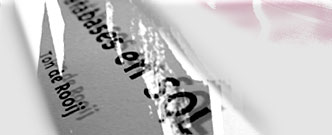Dutch version of this page
Ton de Rooij has written the following books (in reverse order to writing):
Databases and SQL / ISBN 9789082888058 (5th revised edition 2025; first appeared in Dutch in 1996). Translation into English of the Dutch book Databases en SQL.
You can order this book, for example through the website of book shop Paagman.
Databases en SQL / ISBN 9789024457182 (5th revised edition 2023; first appeared in 1996) written in Dutch.
You can order this book, for example through the website of book shop Paagman.
Requirements / ISBN 978 90 828880 4 1 (3rd edition November 2021) written in Dutch.
You can order this book, for example through the website of book shop Paagman.
The second edition of this book (third is being translated) has been translated into English.
ISBN 978 90 828880 3 4 (2nd edition published December 2019) written in English.
Datamodellering / ISBN 978 90 395 2618 7 (1st edition 2010) written in Dutch.
You can order this book, for example through the website of book shop Paagman.
Written together with Peter van Til:
Business Intelligence: De eenduidige informatieomgeving en de gevolgen voor de organisatie / ISBN 978 90 12 12575 8 (1st edition 2008) written in Dutch;
only obtainable through (the company of) Ton de Rooij.
NIAM / ISBN 90 440 0761 0 (4th revised edition 2003; first appeared in 1995) written in Dutch; obtainable through Bol.com and obtainable through (the company of) Ton de Rooij.
Praktijkboek Databases / ISBN 90 267 1177 8; first appeared in 1989; written in Dutch; only obtainable through (the company of) Ton de Rooij.
Uitwerkingen bij Praktijkboek Databases / ISBN 90 267 1428 9; first appeared in 1989; written in Dutch; only obtainable through (the company of) Ton de Rooij.
Programmeertalen voor Databases: SQL en CODASYL 1981 / ISBN 90 267 1335 5; first appeared in 1987; written in Dutch; only obtainable through (the company of) Ton de Rooij.
++++++++++++++++++++++++++++++
Descriptions of the books
++++++++++++++++++++++++++++++
Databases and SQL
ISBN 9789082888058 (5th revised edition 2025 written in English; first published in Dutch in 1996)
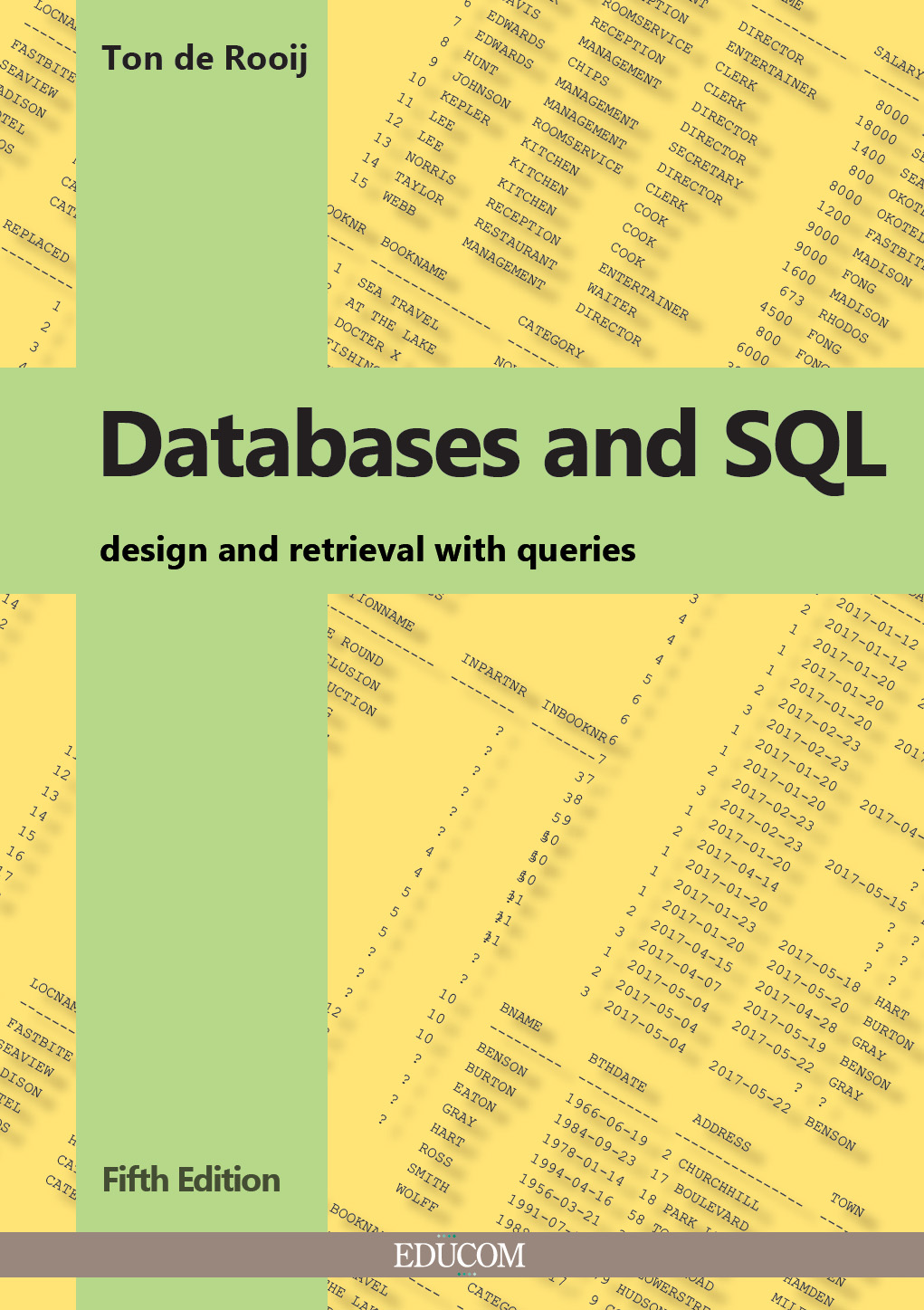
The book explains what a database is and how it can be designed. Practical issues are discussed and a resume is given of normalization as a (n) (outdated) method of designing a database. The second half of the book is dedicated to the query language SQL. The book explains in detail how you can make queries. Not only simple queries, but also the most complicated. Furthermore, the book discusses how you can use SQL to make database tables, and how you can update the content of the database by using SQL updatae statements.
The fifth revised edition (May 2025) is an improvement compared to earlier editions. References to outdated methods and explanations of no longer current database management systems have been removed.
Practice material, consisting of a number of questions and a practice database (Access) can be downloaded through the download page of this site.
This book is used in the English spoken workshop SQL lectured by Ton de Rooij. In this workshop he teaches the participants to make queries that vary from simple to very complex.
Databases en SQL
ISBN 9789024457182 (5th revised edition 2023; first published in 1996); written in Dutch
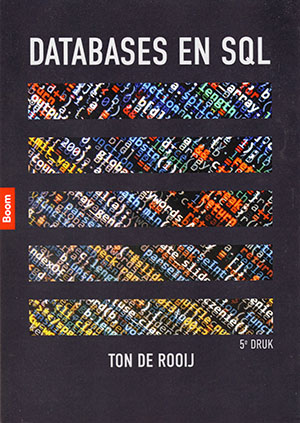
The book explains what a database is and how it can be designed. Practical issues are discussed and a resume is given of normalization as a (n) (outdated) method of designing a database. The second half of the book is dedicated to the query language SQL. The book explains in detail how you can make queries. Not only simple queries, but also the most complicated. Furthermore, the book discusses how you can use SQL to make database tables, and how you can update the content of the database by using SQL updatae statements.
The fifth edition (May 2023) is an improvement compared to earlier editions. References to outdated methods and explanations of no longer current database management systems have been removed.
This Dutch version of the book is used in the Dutch workshop SQL lectured by Ton de Rooij. In this workshop he teaches the participants to make queries that vary from simple to very complex.
The book is also used in the Dutch workshop Database Technologie en Ontwerp (Database Technology and Design) lectured by Ton de Rooij. In this workshop he teaches the participants what a database is, the applications of database technology, and database design.
Requirements
ISBN 978 90 82888 034 (2nd edition December 2019); written in English
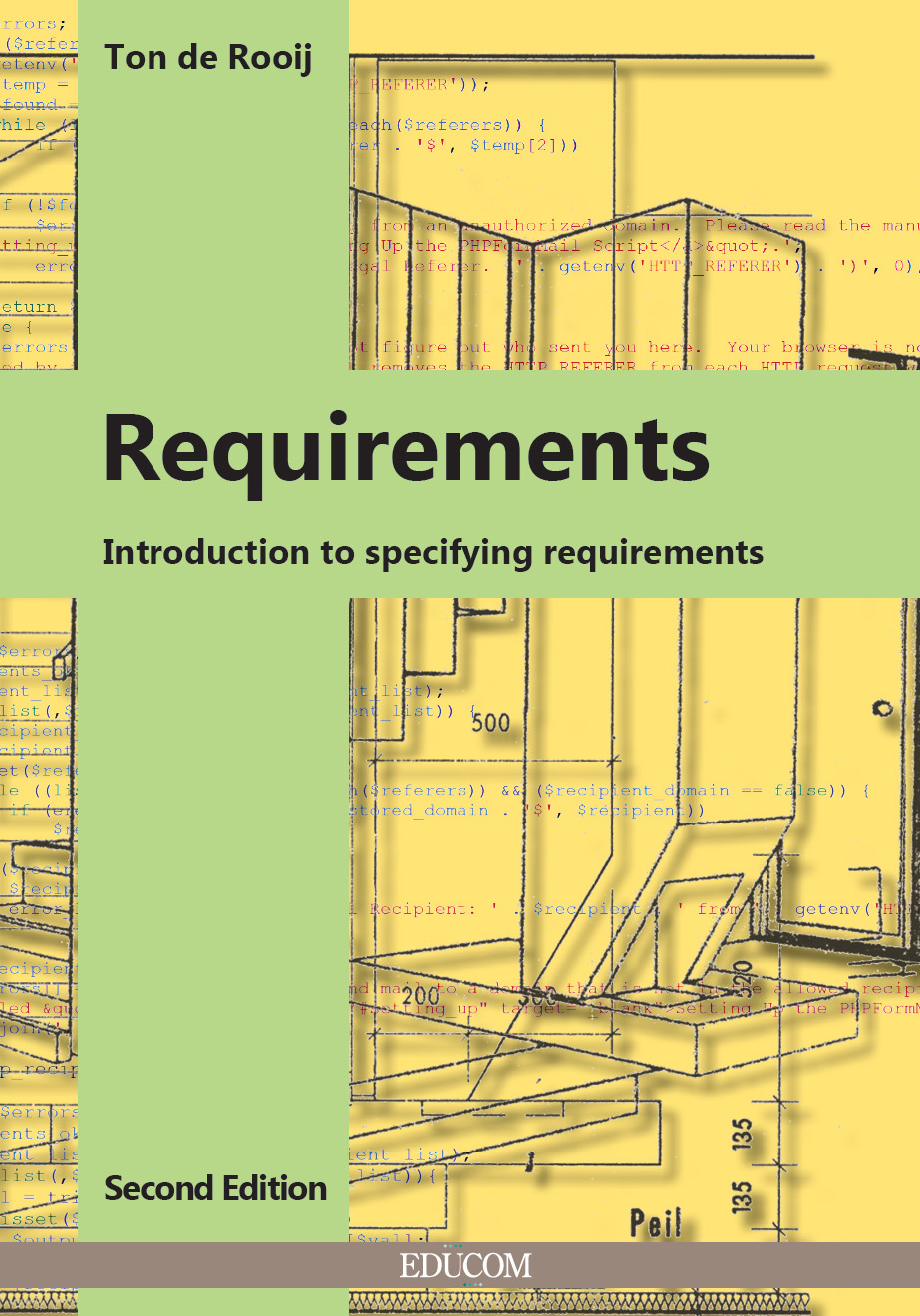
This book explains how to formulate requirements (demands) for an (information) system. In addition to that you learn to distinguish between functional requirements, 'non functional' requirements, and restrictions. After a system has been developed it must be possible to test requirements. The book shows how you can make additions to requirements in order to make it possible to test them. For a system sometimes a huge amount of requirements are formulated. The book points out how you can cluster requirements so you can keep track of them. Furthermore the book shows how to distinguish between requirements and goals (of the organization that wants to have the system) the system has to contribute to. The difference between requirements and solutions for requirements is discussed. Requirements management is discussed, the application of requirements, and how the art factor can make a system more attractive than other systems based on the same set of requirements.
The second edition added six extra chapters in which more depth is given for a number of subjects.
The book is also available in Dutch
ISBN 978 90 828880 4 1 (3rd edition November 2021); written in Dutch
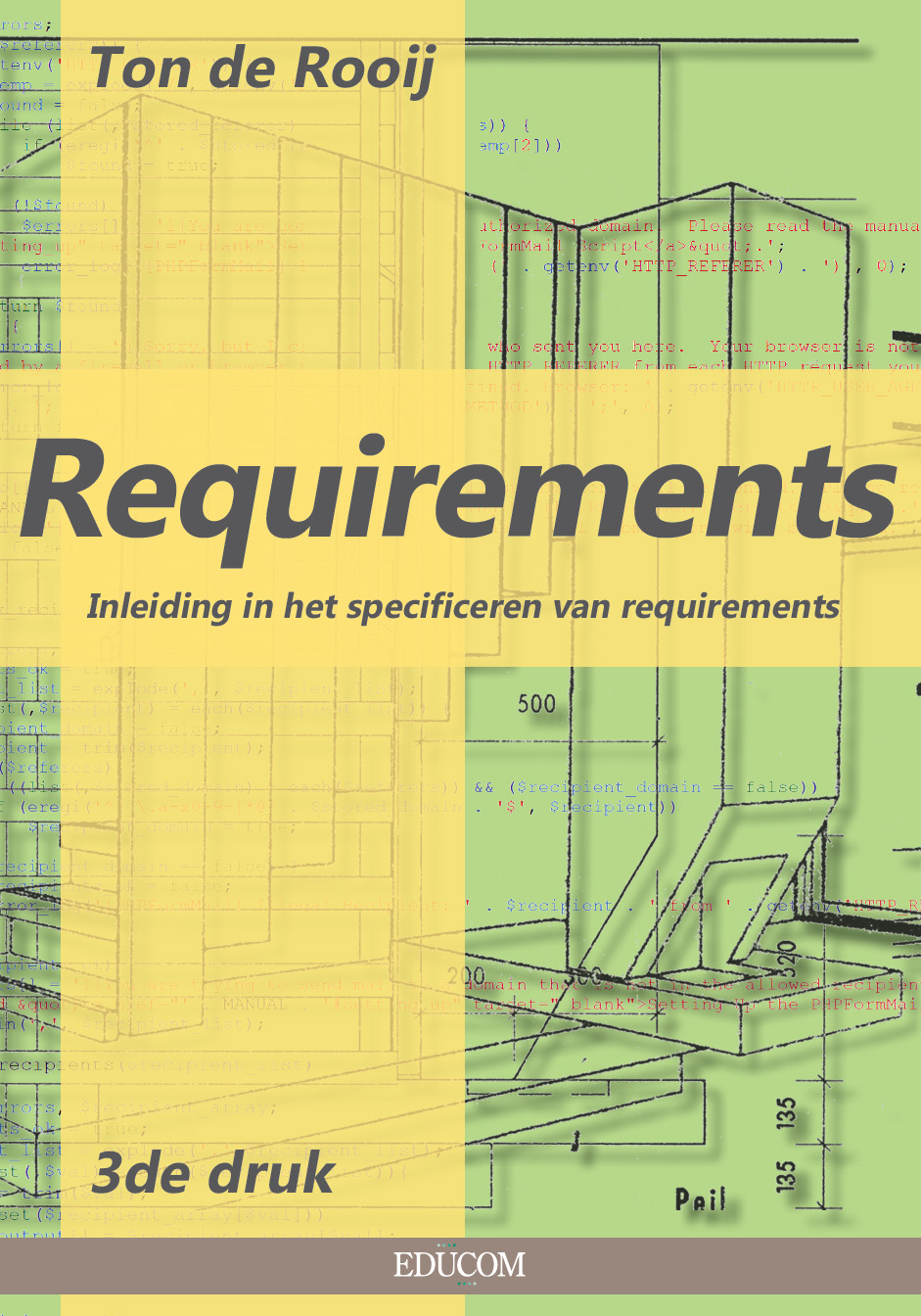
The Dutch version of the book is used in the workshop Requirements Specificeren / Opstellen Requirements which Ton de Rooij lectures himself. In this workshop he teaches the participants the concepts of specifying requirements, and he teaches them how to specify requirements by themselves.
The third edition added more extra chapters, 4 in 122 extra pages. The extra subjects are requirements for data, for databases, for business intelligence and for processes/workflows.
Datamodellering (Data Modeling)
ISBN 978 90 395 2618 7 (1st edition 2010; written in Dutch)
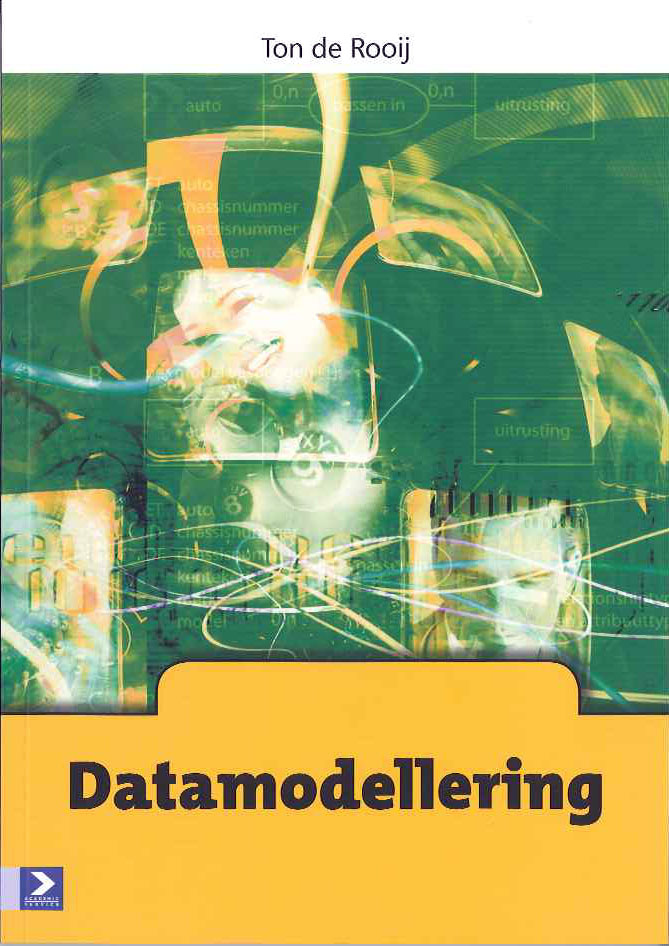
This book explains how you can make a data model, also called an information model, by performing information analysis. The book discusses extensively information analysis, how to support business processes optimally with information, the relation between information gathering and administrative organization. A number of problems that may occur in practice are discussed. The book concludes with how you can use a data model for making a database design.
A data model shows what types of information are needed for performing a specific business process. A data model is an important tool for designing a database, specifying the functional demands for standard software, establishing a data warehouse, making test sets, judging administrative organization, establishing an authorization matrix, and managing information systems.
This book is used in the workshop Datamodellering (data modeling) / Informatieanalyse volgens het ER-model lectured by Ton de Rooij. In this workshop he teaches the participants the concepts of making data models, and he teaches them to make data models themselves. There is an English version of this workshop Data Modeling / Information Analysis using the ER modeling technique. This workhop is also lectured by Ton de Rooij. The book cannot be used for this workshop because it is written in Dutch.
Business Intelligence: De eenduidige informatieomgeving en de gevolgen voor de organisatie
ISBN 978 90 12 12575 8 (1st edition 2008); written in Dutch

This book explains the phenomenon Business Intelligence. The book has a wide range of subjects. The book shows what business intelligence is, and what is needed for executing it (a data warehouse environment).
The book gives many examples which bring the theory to life. It contains a lot of tips for those who want start with Business Intelligence. The book can be used by the more experienced reader, but also by those who want an introduction to the field. It is useful for business managers that have to deal with Business Intelligence.
The book consists of two parts:
- part I: Unambiguous information environment
- part II: Organisation and use
Part I explains how we can set up an environment in which data from many sources can be gathered. It must be possible to use these data as a single integrated set of data. The data have to go through a process of integration which leads to many problems. Part I describes how to deal with this.
Part II describes why we have to do the things that are described in part I. In addition the book discusses how to set up the organization for an unambiguous information environment, the transition process, the testing, maintenance aspects and a project approach.
This book is used in the Dutch spoken workshop Datawarehouses en Business Intelligence and the also Dutch spoken workshop datamodellerern voor Business Intelligence / BI
(stermodellen, kubussen, data vault) lectured by Ton de Rooij. In the first workshop he teaches the participants to deal with Business Intelligence and with Data Warehouse technology. In the second workhop he teaches them to design starmodels, cubes, and data vaults
NIAM
ISBN 90 440 0761 0 (4th revised edition 2003; first publication in 1995; written in Dutch; can only be obtained through Ton de Rooij)

This book shows how you can perform information analysis by using the NIAM method. In addition to that the book shows how you can use NIAM to analyse processes. The explanation is illustrated with examples and an extended description is given of the steps to be taken.
In the fourth edition (November 2003) a few annoying errors have disappeared. Furthermore extra explanations are added to the text. This has been done for:
- the consequences of 'dingsoortsamentrekking' (page 37)
- the n-1 rule (page 47)
- the deduction of obligatory role rules by means of populations (page 49)
- the part 'overige regels' (other rules) by giving an example of such a rule (page 55)
- the functioning of an information system (page 58)
Praktijkboek (Practice book) Databases
ISBN 90 267 1177 8 (first published in 1989; written in Dutch; only obtainable through Ton de Rooij)
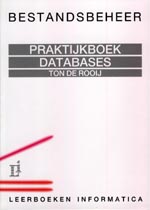
This book enables the reader to practice designing databases and writing of programs for databases. This is done using cases. It starts with practicing information analysis. Answers for ER modeling, NIAM and semantic modeling are given. Answers in the shape of a relational design are given. For the relational design the steps through which the answer is obtained are shown. The table structure of a relational database can be shown by using Bachman diagrams. There are many exercises for writing programs for network databases. There are many exercises for querying a relational database using SQL as well.
Uitwerkingen (answers for) bij Praktijkboek Databases
ISBN 90 267 1428 9 (first published in 1989; written in Dutch; only obtainable through Ton de Rooij)
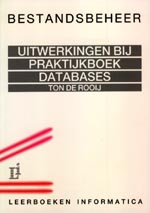
This book contains all answers to the exercises in the book 'Praktijkboek Databases'.
Programmeertalen (Programming Languages for) voor Databases: SQL en CODASYL 1981
ISBN 90 267 1335 5 (first published in 1987; written in Dutch; only obtainable through Ton de Rooij)
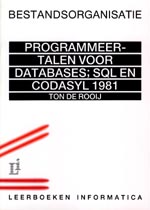
With this book the reader can learn to write programs for network databases and relational databases. The network databases are based on the CODASYL 1981 framework. The relational databases are based on the SQL-2 standard.


